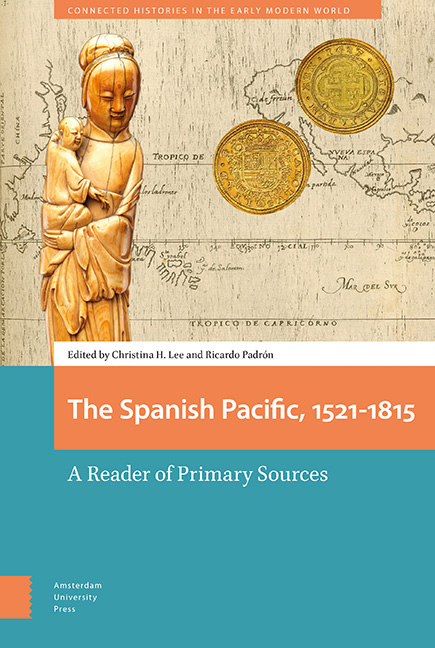Book contents
- Frontmatter
- Contents
- Abbreviations
- Acknowledgements
- Introduction
- 1 An Early Transpacific Account of the Spice Islands by Andrés de Urdaneta (1536)
- 2 Domingo de Salazar’s Letter to the King of Spain in Defense of the Indians and the Chinese of the Philippine Islands (1582)
- 3 Juan Cobo’s Map of the Pacific World (1593)
- 4 A Royal Decree of Philip III Regulating Trade between the Philippines and New Spain (1604)
- 5 Manila’s Sangleys and a Chinese Wedding (1625)
- 6 Don Luis Castilla Offers to Sell Land in Manila (1629)
- 7 Idolatry and Apostasy in the 1633 Jesuit Annual Letter
- 8 The Will of an Indian Oriental and her Chinos in Peru (1644
- 9 Francisco de Combés’s History of Mindanao and Jolo (1667)
- 10 Between Fiction and History in the Spanish Pacific The Misfortunes of Alonso Ramírez (1690)
- 11 A Moluccan Crypto-Muslim before the Transpacific Inquisition (1623–1645)
- 12 Constitutions and Rules of the Beatas Indias (1726)
- 13 The Poetics of Praise and the Demands of Confession in the Early Spanish Philippines: Notes and Documents
- 14 The Pacific Theater of the Seven Years’ War in a Latin Poem by an Indigenous Priest, Bartolomé Saguinsín (1766)
- 15 A Prohibition on Digging Up the Bones of the Dead (1813)
- Index
5 - Manila’s Sangleys and a Chinese Wedding (1625)
Published online by Cambridge University Press: 20 November 2020
- Frontmatter
- Contents
- Abbreviations
- Acknowledgements
- Introduction
- 1 An Early Transpacific Account of the Spice Islands by Andrés de Urdaneta (1536)
- 2 Domingo de Salazar’s Letter to the King of Spain in Defense of the Indians and the Chinese of the Philippine Islands (1582)
- 3 Juan Cobo’s Map of the Pacific World (1593)
- 4 A Royal Decree of Philip III Regulating Trade between the Philippines and New Spain (1604)
- 5 Manila’s Sangleys and a Chinese Wedding (1625)
- 6 Don Luis Castilla Offers to Sell Land in Manila (1629)
- 7 Idolatry and Apostasy in the 1633 Jesuit Annual Letter
- 8 The Will of an Indian Oriental and her Chinos in Peru (1644
- 9 Francisco de Combés’s History of Mindanao and Jolo (1667)
- 10 Between Fiction and History in the Spanish Pacific The Misfortunes of Alonso Ramírez (1690)
- 11 A Moluccan Crypto-Muslim before the Transpacific Inquisition (1623–1645)
- 12 Constitutions and Rules of the Beatas Indias (1726)
- 13 The Poetics of Praise and the Demands of Confession in the Early Spanish Philippines: Notes and Documents
- 14 The Pacific Theater of the Seven Years’ War in a Latin Poem by an Indigenous Priest, Bartolomé Saguinsín (1766)
- 15 A Prohibition on Digging Up the Bones of the Dead (1813)
- Index
Summary
Abstract
This excerpt from Diego de Rueda y Mendoza's True Account of the Funeral Exequies that the Illustrious City of Manila Celebrated to the Death of His Majesty Philip III (1625) provides an eye-witness account of a Catholic Chinese wedding celebrated in Manila during the early seventeenth century. It provides tantalizing glimpses of transculturation among Manila's small Spanish ruling class, as well as insights into the culture of the sangleys, the Chinese residents whose numbers exceeded those of the Spanish by several orders of magnitude. Miguel Martínez places Rueda's account of the wedding within the context of the broader pseudoethnographic work carried out by the True Account, as well as the early history of Manila's sangleys.
Keywords: sangleys; transculturation; early modern ethnography; early Philippine literature
The Sangleys were a populous group of Chinese merchants and artisans who lived in segregated areas around Intramuros, the walled urban core of Spanish Manila. Largely coming from the Fujian region of mainland China, this partly settled and partly floating community provided most of the goods needed daily in the colonial capital and other parts of the Spanish Philippines, and some of its members became crucial actors in the commercial networks that connected the South China Sea and the transpacific trade. After the arrival of the first Fujianese merchants to the riverbanks of the Pasig in the 1570s, the Chinese population of Manila and its surroundings must have largely outnumbered the Spanish colonists almost at any point in history. Their prominence in the social and economic life of the colony and their distinctive treatment vis-à-vis the native Filipino population of the area have led some historians to assert that Spanish Manila was actually a Chinese city.
The following document is a detailed description of Manila's Chinese neighborhoods and people, paying particular attention to everyday life, popular cultural practices, and the activity of the Dominican friars in charge of converting and preaching to the Chinese population of the city.
- Type
- Chapter
- Information
- Spanish Pacific, 1521–1815A Reader of Primary Sources, pp. 73 - 90Publisher: Amsterdam University PressPrint publication year: 2020



